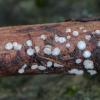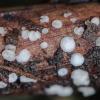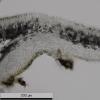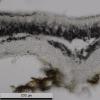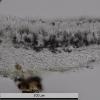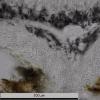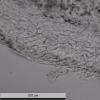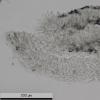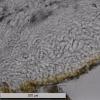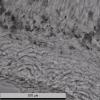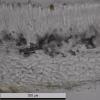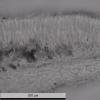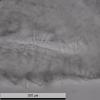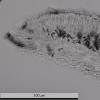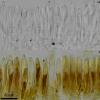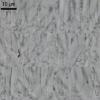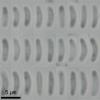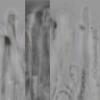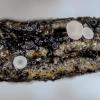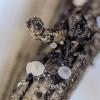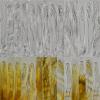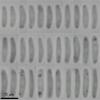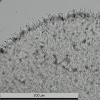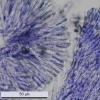
28-12-2025 12:08
Margot en Geert VullingsThis possible Karstenia was found on the bark of d

21-12-2025 21:32
Pol DebaenstHello, Garden, Burgweg 19, Veurne, BelgiumOn 10/1

26-12-2025 21:19
Arnold B├╝schlenPithyella chalaudii Priou. Ist als Bryoparasit in

21-12-2025 09:32
Hello.A tiny ascomycete found embedded in wood in

18-12-2025 21:17
Pol DebaenstThe identification took me to Byssonectria deformi

24-12-2025 17:08
Hulda Caroline HolteHello, I have found this propoloid ascomycete on
Calycellina aff chlorinella 101114 21
Miguel Ángel Ribes,
06-02-2015 00:08
 Good night friends
Good night friendsOn Fagus sylvatica too we found this small < 1mm white with a short stipe Calycellina. The nearest species I found is C. chlorinella.
Asci 8-spores with croziers and inamyloid,┬Ā(34.1) 40.2 - 49.2 (58.0) x (4.8) 5.1 - 6.2 (7.1) ┬Ąm;
N = 51; Me = 44.8 x 5.6 ┬Ąm.
Spores┬Āmore or less cylindrical and slightly curved,┬Ā(5.1) 5.7 - 6.7 (7.4) x (1.3) 1.4 - 1.7 (1.8) ┬Ąm;┬ĀQ = (3.4) 3.6 - 4.5 (4.8); N = 53;┬ĀMe = 6.2 x 1.5 ┬Ąm ; Qe = 4.0.
Paraphysis cylindrical, straight, with a big VB.
Ectal excipulum difficult: angular at base, more and more cylindrical towards the margin.
Medullar excipulum with textura cylindrical.
Hairs short, hialine and smooth, at margen and less abundant at base.
Thank you in advance.
Hans-Otto Baral,
07-02-2015 16:54

Re : Calycellina aff chlorinella 101114 21
Yes Miguel, C. chlorinella is very close. I suggest to place your fungus in my folder chlorinella-luteola which contains the type of Calloria luteola = Orbilia luteola, characterized by inamyloid asci. The apothecia there are either white or yellowish, and occur on bark and wood, or herbaceous stems. Possibly the same fungus is represented by the type of Orbilia veratri (folder chlorinella-veratri), though there the ascus apex is much more thickened in the dead state than in C. luteola..
Zotto
Zotto
Miguel Ángel Ribes,
08-02-2015 21:24

Re : Calycellina aff chlorinella 101114 21
Of course Zotto, but I don't know how to do it. I don't see the option to upload files.
So, I mustn't assign my collection definitely to C. chlorinella?
Thank you.
So, I mustn't assign my collection definitely to C. chlorinella?
Thank you.
Hans-Otto Baral,
08-02-2015 21:44

Re : Calycellina aff chlorinella 101114 21
This was not what I meant :-) Of course I will do, only the upload is presently impossible due to lack of space.
In such cases of little differences (here only iodine reaction), molecular methods would surely help. But no sequence of C. chlorinella is knonw to me, so several samples of each morphotype shpoud be sequenced to see the variation and whether they are different. ┬ĀOnly then we could combine luteola into Calycellina (if they prove to be distinct).
In such cases of little differences (here only iodine reaction), molecular methods would surely help. But no sequence of C. chlorinella is knonw to me, so several samples of each morphotype shpoud be sequenced to see the variation and whether they are different. ┬ĀOnly then we could combine luteola into Calycellina (if they prove to be distinct).
Hans-Otto Baral,
08-02-2015 21:44

Re : Calycellina aff chlorinella 101114 21
This was not what I meant :-) Of course I will do, only the upload is presently impossible due to lack of space.
In such cases of little differences (here only iodine reaction), molecular methods would surely help. But no sequence of C. chlorinella is knonw to me, so several samples of each morphotype shpoud be sequenced to see the variation and whether they are different. ┬ĀOnly then we could combine luteola into Calycellina (if they prove to be distinct).
In such cases of little differences (here only iodine reaction), molecular methods would surely help. But no sequence of C. chlorinella is knonw to me, so several samples of each morphotype shpoud be sequenced to see the variation and whether they are different. ┬ĀOnly then we could combine luteola into Calycellina (if they prove to be distinct).
Miguel Ángel Ribes,
09-02-2015 13:27

Re : Calycellina aff chlorinella 101114 21
Sorry, I didn't understand you about Cubby.
I think I have another collection, from National Park of Ordesa (Huesca), with a doubtful reaction of the asci. I am going to prepare pictures and description to sent it, perhaps this night or tomorrow.
Thank you.
I think I have another collection, from National Park of Ordesa (Huesca), with a doubtful reaction of the asci. I am going to prepare pictures and description to sent it, perhaps this night or tomorrow.
Thank you.
Miguel Ángel Ribes,
09-02-2015 20:07

Re : Calycellina aff chlorinella 101114 21
Hi again
This is the other collection of Calycellina aff chlorinella 031014 01, on Echinospartum horridum, at Huesca, with a difficult interpretation of asci with IKI.
Asci 8-spores with croziers and ┬┐euamyloid?,┬Ā(39.9) 42.9 - 50.0 (52.7) x (4.2) 4.5 - 5.3 (5.5) ┬Ąm;┬ĀN = 23; Me = 46.2 x 4.9 ┬Ąm.
Spores more or less cylindrical, slightly curved and sometimes with 2 small guttules at ends,┬Ā(6.1) 6.8 - 8.5 (8.9) x (1.3) 1.5 - 1.8 (2.0) ┬Ąm;┬ĀQ = (3.6) 3.9 - 5.3 (5.9); N = 48;┬ĀMe = 7.6 x 1.7 ┬Ąm; Qe = 4.6
Hairs short, hialine and smooth, similar to paraphysis, with a big ┬┐VBs? at apice cell.
Thank you
This is the other collection of Calycellina aff chlorinella 031014 01, on Echinospartum horridum, at Huesca, with a difficult interpretation of asci with IKI.
Asci 8-spores with croziers and ┬┐euamyloid?,┬Ā(39.9) 42.9 - 50.0 (52.7) x (4.2) 4.5 - 5.3 (5.5) ┬Ąm;┬ĀN = 23; Me = 46.2 x 4.9 ┬Ąm.
Spores more or less cylindrical, slightly curved and sometimes with 2 small guttules at ends,┬Ā(6.1) 6.8 - 8.5 (8.9) x (1.3) 1.5 - 1.8 (2.0) ┬Ąm;┬ĀQ = (3.6) 3.9 - 5.3 (5.9); N = 48;┬ĀMe = 7.6 x 1.7 ┬Ąm; Qe = 4.6
Hairs short, hialine and smooth, similar to paraphysis, with a big ┬┐VBs? at apice cell.
Thank you
Hans-Otto Baral,
19-02-2015 08:56

Re : Calycellina aff chlorinella 101114 21
Sorry for overlooking this posting. Yes, I think this is typical C. chlorinella. It looks like euamyloid or slightly hemi. And yes, VBs are distinct, I see them on the last pic.
Zotto
Zotto
Miguel Ángel Ribes,
19-02-2015 10:26

Re : Calycellina aff chlorinella 101114 21
Thanks a lot again.
Yes, some apical asci looks like more red-brown than blue.
Cheers.
Yes, some apical asci looks like more red-brown than blue.
Cheers.
